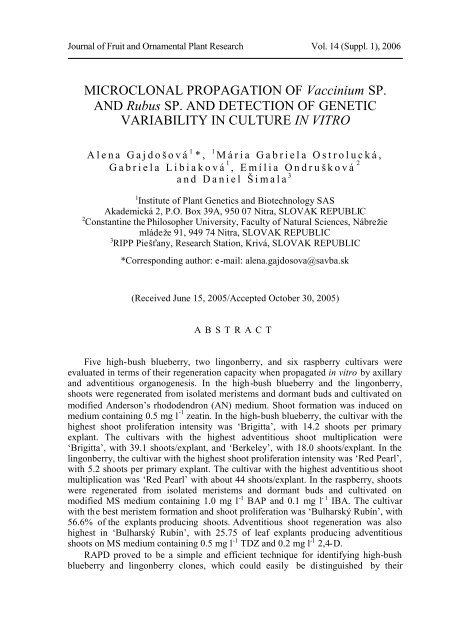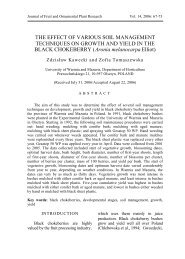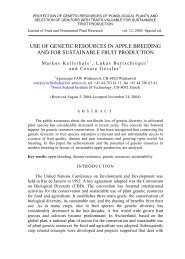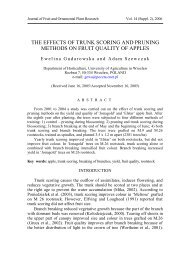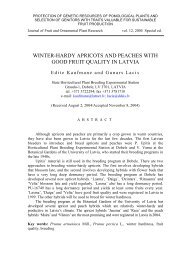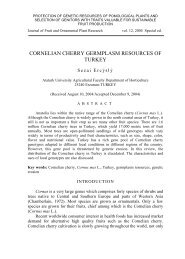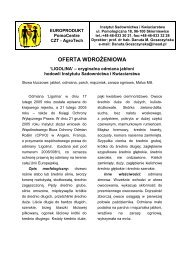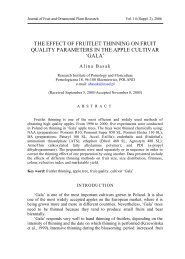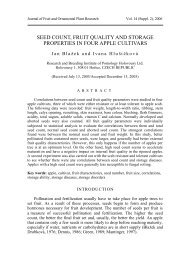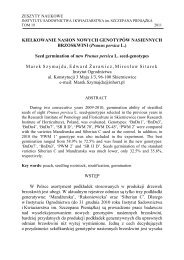MICROCLONAL PROPAGATION OF Vaccinium SP. AND Rubus SP ...
MICROCLONAL PROPAGATION OF Vaccinium SP. AND Rubus SP ...
MICROCLONAL PROPAGATION OF Vaccinium SP. AND Rubus SP ...
You also want an ePaper? Increase the reach of your titles
YUMPU automatically turns print PDFs into web optimized ePapers that Google loves.
Journal of Fruit and Ornamental Plant Research Vol. 14 (Suppl. 1), 2006<strong>MICROCLONAL</strong> <strong>PROPAGATION</strong> <strong>OF</strong> <strong>Vaccinium</strong> <strong>SP</strong>.<strong>AND</strong> <strong>Rubus</strong> <strong>SP</strong>. <strong>AND</strong> DETECTION <strong>OF</strong> GENETICVARIABILITY IN CULTURE IN VITROA l e n a G a j d o šo v á 1 * ,1 M á r i a G a b r i e l a O s t r o l u c k á ,G a b r i e l a L i b i a k o v á 1 , E m í l i a O n d r u šk o v á 2a n d D a n i e l Ši m a l a 31 Institute of Plant Genetics and Biotechnology SASAkademická 2, P.O. Box 39A, 950 07 Nitra, SLOVAK REPUBLIC2 Constantine the Philosopher University, Faculty of Natural Sciences, Nábrežiemládeže 91, 949 74 Nitra, SLOVAK REPUBLIC3 RIPP Piešťany, Research Station, Krivá, SLOVAK REPUBLIC*Corresponding author: e-mail: alena.gajdosova@savba.sk(Received June 15, 2005/Accepted October 30, 2005)A B S T R A C TFive high-bush blueberry, two lingonberry, and six raspberry cultivars wereevaluated in terms of their regeneration capacity when propagated in vitro by axillaryand adventitious organogenesis. In the high-bush blueberry and the lingonberry,shoots were regenerated from isolated meristems and dormant buds and cultivated onmodified Anderson’s rhododendron (AN) medium. Shoot formation was induced onmedium containing 0.5 mg l -1 zeatin. In the high-bush blueberry, the cultivar with thehighest shoot proliferation intensity was ‘Brigitta’, with 14.2 shoots per primaryexplant. The cultivars with the highest adventitious shoot multiplication were‘Brigitta’, with 39.1 shoots/explant, and ‘Berkeley’, with 18.0 shoots/explant. In thelingonberry, the cultivar with the highest shoot proliferation intensity was ‘Red Pearl’,with 5.2 shoots per primary explant. The cultivar with the highest adventitious shootmultiplication was ‘Red Pearl’ with about 44 shoots/explant. In the raspberry, shootswere regenerated from isolated meristems and dormant buds and cultivated onmodified MS medium containing 1.0 mg l -1 BAP and 0.1 mg l - 1 IBA. The cultivarwith the best meristem formation and shoot proliferation was ‘Bulharský Rubín’, with56.6% of the explants producing shoots. Adventitious shoot regeneration was alsohighest in ‘Bulharský Rubín’, with 25.75 of leaf explants producing adventitiousshoots on MS medium containing 0.5 mg l -1 TDZ and 0.2 mg l -1 2,4-D.RAPD proved to be a simple and efficient technique for identifying high-bushblueberry and lingonberry clones, which could easily be distinguished by their
A. Gajdošová et al.characteristic polymorphic banding patterns. However, there were no differences inthe DNA profiles of the mother cultivars and any of the clones derived from them.Therefore, either no somaclonal variation occurred during the micropropagationprocess, or more sensitive techniques are needed to detect it. Flow-cytometry did notdetect any changes in ploidy level, which confirms that no relative changes in DNAcontent took place during the micro-propagation process.Key words: <strong>Vaccinium</strong> sp., <strong>Rubus</strong> sp., in vitro regeneration, RAPD, flow-cytometryAbbreviations: AN – Anderson rhododendron medium; TDZ – thidiazuron; BAP –6-benzylaminopurine; 2-iP – dimethylallylaminopurine; IBA – indole-3-butyric acid;2,4-D – 2,4-dichlorophenoxyacetic acid; DNA – deoxinucleic acid; RAPD – Randomamplified polymorphic DNA analysis.INTRODUCTIONBerry fruits are an economically important crop in many countries.Interest in berry fruits has recently increased because they are excellentsources of health-promoting vitamins, anti-oxidants and other valuablenutrients (Song and Sing, 2004). In Slovakia, however, berry productionsharply decreased during the 1990s in spite of the fact that soil and climateconditions in Slovakia are excellent for the intensive cultivation of berryfruits. There are also many unique berry cultivars which lend themselves tointensive cultivation. Recently, interest in growing various berry fruits hadbeen increasing not only among home gardeners, but also among smallfarmers. Berry culture is increasing in sub-mountainous areas of the country,where soil and climate conditions are more favorable for intensive berryculture than in the lowland areas.Some berry cultivars recently introduced into Slovakia are potentiallyprofitable alternative and non-conventional fruit crops. Among them arecultivars of the high-bush blueberry (<strong>Vaccinium</strong> corymbosum L.), the lingonberry(<strong>Vaccinium</strong> vitis-idaea L.), and the raspberry (<strong>Rubus</strong> idaeus L.). InSlovakia, lingonberry production has predominantly relied on the collection ofthe berries from stands of native varieties growing wild in the mountains.Habitat destruction has lead to a reduction in the supply of nativelingonberries. Although these native wild varieties are not as suitable forintensive culture as are the new cultivars, they are still very valuable becauseof their high dietary value and breeding potential. They can be a versatile rawmaterial for the food processing and pharmaceutical industries.High-bush blueberry and lingonberry plantations have already beenestablished at the Research Station of the Grassland and MountainAgricultural Research Institute in Krivá na Orave in northern Slovakia.Various berry cultivars are propagated by cuttings at this station. The genus<strong>Rubus</strong> includes many valuable cultivated species and varieties. <strong>Rubus</strong>varieties are propagated vegetatively. However, traditional techniques are not104J. Fruit Ornam. Plant Res. vol. 14 (Suppl. 1), 2006: 103-119
Microclonal propagation of <strong>Vaccinium</strong> sp. and <strong>Rubus</strong> sp. …very efficient. The number of propagules which can be produced is limited byseasonal growth rate. <strong>Rubus</strong> species are susceptible to a wide variety of viraland fungal diseases. For this reason, plantations should be planted at higheraltitudes. Intensive <strong>Rubus</strong> breeding and propagation programs are underway atthe Research Institute of Fruit and Ornamental Plants in Bojnice in westernSlovakia.When establishing commercial berry plantations, it is essential to plantcertified pathogen-free new cultivars which produce well at higher elevations.Microbial pathogens can be transferred during vegetative propagation ofplants. Traditional propagation methods are also not very efficient in terms ofthe number of propagules generated. These limitations can be overcome bythe use of in vitro techniques, which ensure a reliable supply of healthy,pathogen-free planting material (Tsao et al., 2000; O‘Herlihy et al., 2003).The aim of this study was to develop and test efficient in vitroregeneration and propagation systems which can be used with high-bushblueberry, lingonberry and raspberry cultivars. Another goal was to evaluateRAPD as an inexpensive technique to identify <strong>Vaccinium</strong> cultivars and togenetically characterize clones derived from in vitro culture. Flow-cytometrywas used to evaluate clonal fidelity and variability in vegetatively propagatedplant material which had been cultured in vitro for several months.MATERIAL <strong>AND</strong> METHODSFive high-bush blueberry, two lingonberry, and six raspberry cultivarswere evaluated in terms of their regeneration capacity when propagated invitro.The high-bush blueberry cultivars tested were: ‘Berkeley’, ‘Bluecrop’,‘Blueray’, ‘Duke’ and ‘Brigitta’. The lingonberry cultivars tested were: ‘RedPearl’, ‘Koralle’. The raspberry cultivars tested were: ‘Bojana’, ‘Afrodita’,‘Granát’, ‘Ada’, ‘Medea’ and ‘Bulharský Rubín’.Shoots were regenerated directly from isolated meristems, dormant apicalbuds, and dormant axillary buds. Stem cutting with dormant buds werecollected in January and February from mature plants growing in the field.Nodal segments bearing one bud apiece were washed under running water,sterilized for two minutes in 70% ethanol, soaked for six minutes in a solutioncontaining HgCl 2 and Tween, and finally washed three times for fifteenminutes in sterile distilled water.In vitro cultureAll cultures were maintained in a growth chamber at 23 2 o C using a 16 h light/8h dark photoperiod. Light was supplied using white fluorescent lamps at an intensityof 50 mol m -2 s -1J. Fruit Ornam. Plant Res. vol. 14 (Suppl. 1), 2006: 103-119 105
A. Gajdošová et al.High-bush blueberries and lingonberriesShoots were regenerated from isolated meristems and dormant buds andcultivated on Anderson’s rhododendron medium supplemented with 30 mg l -1sucrose, 8 mg l -1 phyto agar, and 0.5 mg l -1 zeatin, pH 4.8 to 5.0 (Anderson,1980). Leaves with cut margins were placed horizontally on the mediumabaxial surface down.In the high-bush blueberry, adventitious buds were induced on ANmedium containing 0.5 mg l -1 zeatin.In the lingonberry, adventitious buds were induced by first culturing theexplants on AN medium containing either 2.19 mg l-1 or 4.38 mg l -1 zeatin.After six weeks, the explants were transferred to AN medium containing0.5 mg l -1 zeatin.After three subculture cycles each lasting five or six weeks, the high-bushblueberry and lingonberry cultivars were evaluated in terms of regenerationability based on shoot proliferation intensity. Shoot proliferation was enhanced bydividing regenerated elongated micro-shoots into single-node segments. Shootproliferation intensity is defined as the average number of shoots produced by theend of the third subculture cycle by the primary explant and the micro-shootcuttings derived from it. The percentage of leaves which had produced callus andregenerated shoots after six weeks of culture was also recorded.RaspberriesShoots were regenerated from isolated meristems and dormant buds andcultivated on modified MS medium containing 1.0 mg l -1 BAP and 0.1 mg l -1IBA (Gajdošová et al., 2000). The same medium was used for shootmultiplication.Adventitious buds were induced by cultivating leaves and stem cuttings ofin vitro plants on modified MS medium and AN medium containing thefollowing growth regulators:TDZ: 0.1, 0.5 or 1.0 mg l -1 , alone or in combination with 0.2 mg l -1 2,4-D;andBAP: 0.5 or 1.0 mg l -1 in combination with 0.5 mg l -1 IBA.Shoots were rooted on modified MS medium containing 1mg l -1 IBA.RAPD analysisRAPD analysis was performed on clones of selected high-bush blueberryand lingonberry cultivars after several months of in vitro culture. Leaves ofthe field grown mother plants were used as the controls.DNA was isolated using the King Fisher Genomic DNA PurificationKit in accordance with the procedure recommended by the manufacturer(Thermo Labsystems, Helsinki, Finland). The extraction protocol had to bemodified to prevent problems caused by the presence of polyphenols. 1% PVPwas added to the lysis buffer, and later also to the PCR reaction mixture.106J. Fruit Ornam. Plant Res. vol. 14 (Suppl. 1), 2006: 103-119
Microclonal propagation of <strong>Vaccinium</strong> sp. and <strong>Rubus</strong> sp. …DNA polymorphism was analysed using the Operon decamer primer Kit(Operon Technologies, Inc.). Twenty OPU primers of arbitrary sequence werescreened.. PCR was repeated at least twice for each primer. The products werethen separated and the obtained DNA patterns were analyzed.Flow cytometryFlow cytometry was performed using the PA II ploidy analyzer with amercury arc lamp using UV excitation. Samples were prepared in a two-stepprocedure using the Partec CyStain UV precise P reagent kit containingDAPI. Analysis was carried out on young high-bush blueberry andlingonberry leaves from in vitro plants. The high-bush blueberry cultivartested was ‘Berkeley’, and the lingonberry cultivar tested was ‘Red Pearl’.Four clones of each cultivar were tested: three derived from regeneratedadventitious shoot, and one derived from meristem.RESULTSHigh-bush blueberries and lingonberriesOur results confirm that high-bush blueberries and lingonberries can beefficiently propagated by direct organogenesis.Figure 1. Shoot proliferation from dormant buds in the high-bush blueberry cultivar‘Berkeley’ on both AN medium without zeatin and AN medium containing 0.5 mg l -1zeatin after ten weeks of cultureIn the high-bush blueberry, multi-shoot cultures were obtained bycultivating apical and axillary buds on AN culture medium containing0.5 mg l -1 zeatin. Shoot proliferation intensity varied widely depending oncultivar. The cultivar with the highest shoot proliferation intensity was‘Brigitta’, with 14.2 shoots per primary explant. The cultivars with the lowestshoot proliferation intensities were ‘Duke’, with 2.3 shoots/explant, and‘Blueray’, with 2.9 shoots/explant (Fig. 1). Previous experiments on high-J. Fruit Ornam. Plant Res. vol. 14 (Suppl. 1), 2006: 103-119 107
A. Gajdošová et al.bush blueberries showed that shoot proliferation intensity depends on theconcentration of zeatin in the culture medium (Ostrolucká et al., 2002). In ourstudy, ‘Duke’ formed 2.3 shoots/explant on medium containing 0.5 mg l -1zeatin, and 5.3 shoots/explant on medium containing 2.0 mg l -1 zeatin.In the lingonberry, multi-shoot cultures were obtained by initially cultivatingapical and axillary buds on AN culture medium containing either 2.19 mg l-1 or4.38 mg l -1 zeatin, and then transferring then to AN medium containing 0.5 mg l -1zeatin after six weeks. Shoot proliferation intensity depended on cultivar. ‘RedPearl’ formed 5.2 shoots/explant, and ‘Koralle’ formed 2.8 shoots/explant. Thenumber of shoots produced per primary explant could be increased by dividingmicro-shoots into single-node segments. Segmentation was particularly effectivewith the blueberry cultivar ‘Duke’ and the lingonberry cultivar ‘Koralle’. Withsegmentation, shoot proliferation intensity increased to 4.6 in ‘Duke’, and to 4.4in ‘Koralle’ (Fig. 2).161412N umb e r of e xp la n ts1086420Brigitta Bluecrop Berkelley D uke Blueray Red Pearl KoralleM ean num ber of shoots per explantM ean total number of s hoots per explantFigure 2. Influence of zeatin (0.5 mg l -1 ) on regeneration in of high-bush blueberryand lingonberry cultivarsAdventitious organogenesis can be used to scale up clonal production inselected <strong>Vaccinium</strong> genotypes. We have developed a very efficient procedurefor regenerating adventitious shoots from leaf tissue in high-bush blueberriesand lingonberries.In the high-bush blueberry, leaf explants produced multiple shoots aftersix weeks of culture on AN medium containing 0.5 mg l -1 zeatin withoutgoing through an intermediary callus phase. Regenerative capacity varied108J. Fruit Ornam. Plant Res. vol. 14 (Suppl. 1), 2006: 103-119
Microclonal propagation of <strong>Vaccinium</strong> sp. and <strong>Rubus</strong> sp. …widely depending on cultivar. Two cultivars had particularly high shootmultiplication rates: ‘Brigitta’, with 39.1 shoots/explant; and ‘Berkeley’, with18.0 shoots/explant. Both of these cultivars exhibited a high regenerativecapacity, as expected for apical and axillary bud cultures (Tab. 1).T a b l e 1 . Adventitious shoot regeneration from leaf tissue in the high-bushblueberry (<strong>Vaccinium</strong> corymbosum L.)CultivarNumberof leafexplantsPercentageof explantsregeneratingshootsMeanshootsperexplantMultiplication of adventitiousshootsfirstsubculturesecondsubcultureBerkeley 20 35 18.0 110.0 237.1Bluecrop 20 10 5.8 13.3 50.3Brigitta 20 40 39.1 129.4 257.5In the lingonberry, leaf explants produced adventitious shoots only aftergoing through an intermediary callus phase. After six weeks on AN mediumcontaining either 2.19 or 4.38 mg l -1 zeatin, leaf and stem explants formedcallus tissue, but did not regenerate shoots. A higher percentage of callusformation was observed in stem explants. At this stage, the calluses weretransferred to AN medium containing 0.5 mg l -1 zeatin. In ‘Red Pearl’,adventitious shoots formed on calluses derived from both leaf and stemexplants (Tab. 2). More buds formed on callus derived from leaf explants(Fig. 3). The shoots produced were directly rooted in a peat substrate afterbeing dipped in a solution containing 1.0 mg l -1 IBA. In ‘Koralle’, althoughthe explants formed callus tissue, they did not regenerate shoots even afterbeing transferred to AN medium containing 0.5 mg l -1 zeatin.T a b l e 2 . Indirect regeneration of adventitious shoots in the lingonberry(<strong>Vaccinium</strong> vitis-idaea L.)CultivarPrimaryexplantsNumberofexplants2.19 mg l -1zeatin (A)Shoot regeneration by callogenesisAnderson culture medium4.38 mg l -1zeatin (B)callus [%] callus [%]0.5 mg l -1zeatinA Bnumber ofshoots fromcallusmeanshootsperexplantRed leaf 36 13.3 23.3 864 728 44.22Pearl stem 6 83.3 83.3 207 59 44.33Koralleleaf 30 13.3 16.6 0 0 0stem 6 16.6 16.6 0 0 0J. Fruit Ornam. Plant Res. vol. 14 (Suppl. 1), 2006: 103-119 109
A. Gajdošová et al.Figure 3. Induction ofadventitious buds incallus derived from leaftissue in the lingonberrycultivar ‘Read Pearl’after eight weeks ofculture on AN mediumcontaining 0.5 mg l -1zeatinRaspberriesFigure 4. Shoot regeneration from dormant buds in the raspberry cultivar ‘BulharskýRubín’ cultured on modified MS medium containing 1.0 mg l -1 BAP and 0.1 mg l -1 IBA110J. Fruit Ornam. Plant Res. vol. 14 (Suppl. 1), 2006: 103-119
Microclonal propagation of <strong>Vaccinium</strong> sp. and <strong>Rubus</strong> sp. …Shoot regeneration in the raspberry cultivars tested depended on genotype,culture medium and growth regulators. Apical and axillary buds producedadventitious shoots on modified MS medium containing 1 mg l -1 BAP and0.1mg l -1 IBA. Regenerative capacity varied widely depending on cultivar.The percentage of buds producing shoots was 56.6% in ‘Bulharský Rubín’,53.8% in ‘Afrodita’, 52.6% in ‘Granát’, 47.1% in ‘Ada’, and 44.8% in‘Bojana’ (Fig. 4). The mean number of shoots per explant followed the sametrend, ranging from a high of 13.9 in ‘Bulharský Rubín’ to a low of 2.3 in‘Medea’. Shoot multiplication was also efficient on modified MS mediumcontaining 1mg l -1 BAP and 0.1mg l -1 IBA.The cultivars also differed in their capacities to form adventitious buds.Adventitious bud induction was successful in three cultivars: ‘Miral’,‘Afrodita’ and ‘Bulharský Rubín’. In ‘Miral’ and ‘Afrodita’, adventitiousbuds formed on hypocotyl explants cultured on medium containing 1.0 mg l -1BAP and 0.5 mg l -1 IBA.Figure 5. Adventitious shoot regeneration in the raspberry cultivar ‘Bulharský Rubín’cultured on modified MS medium containing 0.5 mg l -1 TDZ and 0.2 mg l -1 2,4-DThe best results were obtained with leaf explants of ‘Bulharský Rubin’cultured on MS medium containing 0.5 mg l -1 TDZ and 0.2 mg l -1 2,4-D (Fig.5). 27.5% of these explants regenerated adventitious shoots. On mediumcontaining only 0.1 mg l -1 TDZ, shoot regeneration was sporadic. On the otherhand, on medium containing 1.0 mg l -1 TDZ, explant necrosis occurred.J. Fruit Ornam. Plant Res. vol. 14 (Suppl. 1), 2006: 103-119 111
A. Gajdošová et al.RAPD analysisRAPD analysis using King Fisher equipment proved to be a simple andefficient technique for identifying high-bush blueberry and lingonberrycultivars. The high-bush blueberry cultivars ‘Bluecrop’, ‘Blueray’ and ‘Duke’could easily be distinguished by their characteristic banding patterns (Fig. 6).Figure 6. DNA profiles of the high-bush blueberry cultivars ‘Duke’ (D), ‘Blueray’ (B)and ‘Bluecrop’ (BC)Figure 7. DNA profiles of in vitro derived clones of the lingonberry cultivar ‘RedPearl’ and the high-bush blueberry cultivar ‘Brigitta’112J. Fruit Ornam. Plant Res. vol. 14 (Suppl. 1), 2006: 103-119
Microclonal propagation of <strong>Vaccinium</strong> sp. and <strong>Rubus</strong> sp. …The primers tested differed widely in their capacity to amplify the DNA ofdifferent cultivars and clones. Of the twenty primers screened, the ones whichproduced the most polymorphic bands were OPU 3, OPU 13, OPU 14 andOPU 15. However, there were no differences in the DNA profiles of themother plants and any of the clones derived from them (Fig. 7). Therefore,either no Somaclonal variation occurred during the micro-propagationprocess, or more sensitive techniques are needed to detect it.Flow-cytometry analysisFlow-cytometry did not detect any changes in the ploidy level of theclones derived from in vitro culture. This confirms that no relative changes inDNA content took place during the micro-propagation process (Fig. 8).Figure 8. Flow-cytometry histograms of the high-bush blueberry cultivar ‘Berkeley’and the lingonberry cultivar ‘Red PearlDISCUSSIONIn many countries, in vitro micropropagation has already successfullybeen used to accelerate the testing and release of various new <strong>Vaccinium</strong>cultivars, including high-bush blueberries and lingonberries (Marcotrigiano etal., 1996; Reed and Abdelnour-Esquivel, 1991; Shibli and Smith, 1996;Popowich and Filipenya, 1997; Jaakola et al., 2001; Cao et al., 2003). InSlovakia, these techniques have not yet been widely used.Inducing adventitious bud formation in cultures derived from leaf tissuehas been reported to be promising technique not only for the propagation ofJ. Fruit Ornam. Plant Res. vol. 14 (Suppl. 1), 2006: 103-119 113
A. Gajdošová et al.new genotypes, but for genetic transformation as well (Rowland and Ogden,1992; Cao and Hammerschlag, 2000; Debnath and McRae, 2002; Song andSing, 2004; Petri and Burgos, 2005). These studies have focused ondetermining optimal conditions for efficient in vitro regeneration.Our results confirm that zeatin is a good agent for inducing multiple shootformation in bud and meristem cultures. Zeatin also promotes adventitiousorganogenesis. Zeatin is more effective than 2-iP in inducing shootregeneration in <strong>Vaccinium</strong> sp. (Rowland and Ogden, 1992; Ondrušková et al.,2003; Ostrolucká et al., 2002). Zeatin at a concentration of 4.0 mg l -1 has beenused to initiate shoot formation (Reed and Abdelnour-Esquivel, 1991).Medium containing either 4.38 or 6.57 mg l -1 zeatin has been used to inducemultiple shoot formation in leaf explants (Debnath and McRae, 2002). In ourexperience, zeatin at a concentration of 0.5 mg l -1 worked best. Higherconcentrations promoted callus formation, and shoot regeneration took placeonly after the calluses were transferred to media containing 0.5 mg l -1 zeatin.Zeatin concentration influences not only shoot multiplication, butmorphogenesis as well. Other studies have shown that higher concentrationsof zeatin promote callus formation in leaf explants (Shibli and Smith, 1996).The cultivars tested varied widely in terms of shoot proliferation intensityeven though they were all cultured on the same medium. This confirms thatshoot proliferation intensity depends on genotype, which agrees with earlierreports (Popowich and Filipenya,1997).An in vitro culture system has been developed for the rapid micropropagationof new <strong>Rubus</strong> cultivars and hybrids (Cousineau and Donnelly,1991; Turk et al., 1994). In vitro culture of meristems has been used toproduce healthy, high quality planting material which can be propagatedeither in vitro or with conventional techniques (Graham et al., 1997;Hollmann et al., 2002). Other researchers have also found that <strong>Rubus</strong> speciescan be successfully regenerated with in vitro techniques (Mezzetti et al., 1997;Barrett et al., 1996).In our study, in vitro shoot proliferation in raspberries was successfullyinduced by culturing dormant buds on modified MS medium containing1 mg l -1 BAP and 0.1 mg l -1 IBA. This agrees well with earlier studies(Donnelly et al., 1980; Palonen and Buszard, 1998). Zeatin at a concentrationof 1.0 mg l -1 was found to stimulate shoot proliferation better than BAP at aconcentration of 2.0 mg l -1 in combination with IBA or NAA (Debnath, 2004).However, leaf number and shoot vigor were higher with BAP and IBA. In ourstudy, the shoots induced on medium containing 1.0 mg l -1 BAP and 0.1mg l -1IBA were robust, grew well, and multiplied at a high rate.Regenerative capacity in raspberries varied greatly depending ongenotype, which agrees well with earlier reports (Graham et al., 1997). Wesucceeded in inducing adventitious shoot regeneration we obtained in ‘Miral’,‘Afrodita’ and ‘Bulharský Rubín’. In ‘Miral’ and ‘Afrodita’, adventitious114J. Fruit Ornam. Plant Res. vol. 14 (Suppl. 1), 2006: 103-119
Microclonal propagation of <strong>Vaccinium</strong> sp. and <strong>Rubus</strong> sp. …buds formed on hypocotyl explants cultured on medium containing 1.0 mg l -1BAP and 0.5 mg l -1 IBA. The best results were obtained with leaf explants of‘Bulharský rubín’ cultured on MS medium containing 0.5 mg l -1 TDZ and 0.2mg l -1 2,4-D. In the blackberry, TDZ has been found to stimulate adventitiousshoot formation better than BAP (Hassan et al., 1993). In some raspberrycultivars, TDZ alone or in combination with IBA effectively inducedadventitious bud formation (Graham et al., 1997). However, when TDZ wasused at higher concentrations or in combination with 2,4-D, shootregeneration was completely inhibited in all cultivars. In our study, TDZ athigher concentrations caused explant necrosis. Therefore, we will use anotherauxin in future experiments.RAPD is a simple and reliable molecular technique that had been used toidentify cultivars and clones and to determine inter-relatedness in manyperennial woody species, including <strong>Vaccinium</strong> species (Persson andGustavsson, 2001; Arce-Johnson et al., 2002). In the bilberry (V. myrtillus),RAPD and AFLP (Amplified Fragment Length Polymorphism) have beentested for their usefulness in clone identification (Albert et al., 2003; 2004).Both RAPD and AFLP yielded the same results, which mean that bothtechniques are reliable.Our results show that RAPD is a reliable technique for identifyingblueberry cultivars. The cultivars tested produced distinct banding patterns.However, we had to screen several primers to find ones which amplified DNAin the cultivars tested. Furthermore, PCR had to be repeated several times inorder to obtain readable banding patterns.In the cranberry (V. macrocarpon), RAPD have been successfully used todistinguish varieties. However, RAPD has some limitations. Several reactionswith several primers are required to reliably identify each clone. Also,artefacts often make accurate identification difficult (Polashock and Vorsa,2002). In the study on the high-bush blueberry, the genetic relations amongthe genotypes tested determined by RAPD analysis did not agree well withknown pedigree data (Levi and Rowland, 1997). In the peach, RAPD has beenused to detect somaclonal variants in regenerated clones (Hashmi et al.,1997).Also in the kiwi fruit, both RAPD and SSR were used to detect somaclonalvariants (Palombi and Damiano, 2002).In our experiments, there were no differences in the DNA profiles of themother plants and any of the clones derived from them by either axillary oradventitious organogenesis. Flow cytometry did not detect any changes in theploidy level of the clones derived from in vitro culture within a single cultivar.We can therefore conclude that more specific techniques have to be usedto detect somaclonal variation in micro-propagated plants. Among thetechniques which should be further investigated are SSR, EST-PCR (Rowlandet al., 2003a; Rowland et al., 2003b).J. Fruit Ornam. Plant Res. vol. 14 (Suppl. 1), 2006: 103-119 115
A. Gajdošová et al.Acknowledgements. This project was supported by the Slovakian GrantAgency VEGA, project no. 2/5128/25. RAPD and flow-cytometry analyseswere performed during COST 843 STSMs in Finland and Germany.REFERENCESAlbert T., Raspé O., Jacquemart A.L. 2003. Clonal structure in <strong>Vaccinium</strong> myrtillusL. revealed by RAPD and AFLP markers. INT. J. PLANT SCI. 164: 649-655.Albert T., Raspé O., Jacquemart A.L. 2004. Clonal diversity and genetic structure in<strong>Vaccinium</strong> myrtillus populations from different habitats. BELG. J. BOT. 137: 155-162.Anderson W.C. 1980. Tissue culture propagation of red and black raspberries, <strong>Rubus</strong>idaeus and R. occidentalis. ACTA HORT. 112: 124-132.Arce-Johnson P., Rios M., Zuniga M., Vergara E. 2002. Identification of blueberryvarietes using random amplified polymorphic DNA markers. ACTA HORT. 574:221-224.Barrett C., Cobb E., McNicol R., Lyon G. 1996. A risk assessment study of plantgenetic transformation using Agrobacterium and implications for analysis oftransgenic plants. PLANT CELL TISSUE ORGAN CULTURE 47: 135-144.Cao X., Hammerschlag F.A. 2000. Improved shoot organogenesis from leaf explantsof highbush blueberry. HORTSCIENCE 35: 945-947.Cao X., Fordham I., Douglass L., Hammerschlag F. 2003. Sucrose level influencesmicropropagation and gene delivery into leaves from in vitro propagated highbushblueberry shoots. PLANT CELL TISSUE ORGAN CULTURE 75: 255-259.Cousineau J.C., Donnelly D.J. 1991. Adventitious shoot regeneration from leafexplants of tissue cultured and greenhouse-grown raspberry. PLANT CELLTISSUE ORGAN CULTURE 27: 249-255.Debnath S.C. 2004. Clonal propagation of dwarf raspberry (<strong>Rubus</strong> pubescens Raf.) throughin vitro axillary shoot proliferation. PLANT GROWTH REGUL. 43: 179-186.Debnath S.C., McRae K.B. 2002. An efficient adventitious shoot regeneration systemon excised leaves of micropropagated lingonberry (<strong>Vaccinium</strong> vitis-idaea L.). J.HORT. SCI. BIOTECH. 77: 744-752.Donnelly D.J., Stace-Smith R., Mellor F.C. 1980. In vitro culture of three <strong>Rubus</strong>species. ACTA HORT. 112: 69-75.Gajdošová A., Libiaková G., Ostrolucká M.G., Košťálová M., Beneová A. 2000.Regeneration and reproduction of some fruit tree species under in vitroconditions. Proc. 4 th Scientific Conference „Propagation of OrnamentalPlants“,Oct.7-9, 2000, Sofia, Bulgaria, ISBN 954-8783-34-7, pp. 58-64.Graham J., Iasi L., Millam S. 1997. Genotype-specific regeneration from a number of<strong>Rubus</strong> cultivars. PLANT CELL TISSUE ORGAN CULTURE 48: 167-173.Hassan M.A., Swartz H.J., Inamine G., Mullineaux Ph. 1993. Agrobacteriumtumefaciens-mediated transformation of several <strong>Rubus</strong> genotypes and recovery oftransformed plants. PLANT CELL TISSUE ORGAN CULTURE 33: 9-17.116J. Fruit Ornam. Plant Res. vol. 14 (Suppl. 1), 2006: 103-119
Microclonal propagation of <strong>Vaccinium</strong> sp. and <strong>Rubus</strong> sp. …Hashmi G., Huettel R., Meyer R., Krusberg L., Hammerschlag F. 1997. RAPDanalysis of somaclonal variants derived from embryo callus cultures of peach.PLANT CELL REP. 16: 624-627.Hollmann P.J., Lohbrunner G.K., Shamoun S.F., Lee S.P. 2002. Establishment andcharacterization of <strong>Rubus</strong> tissue culture systems for in vitro bioassays againstphytotoxins from <strong>Rubus</strong> fungal pathogens. PLANT CELL TISSUE ORGANCULTURE 68: 43-48.Jaakola L., Tolvanen A., Laine K., Hohtola A. 2001. Effect of N 6 -isopentenyladenineconcentration on growth initiation in vitro and rooting of bilberry andlingonberry. PLANT CELL TISSUE ORGAN CULTURE 66: 73-77.Levi A., Rowland L.J. 1997. Identifying blueberry cultivars and evaluating theirgenetic relationships using randomly amplified polymorphic DNA (RAPD) andsimple sequence repeat-(SSR-) anchored primers. J. AMER. SOCI. HORT. SCI.122: 74-78.Marcotrigiano M., McGlew S.P., Hackett G. Chawla B. 1996. Shoot regenerationfrom tissue-cultured leaves of the American cranberry (<strong>Vaccinium</strong> macrocarpon).PLANT CELL TISSUE ORGAN CULTURE 44: 195-199.Mezzetti B., Savini F., Carnevali F., Mott D. 1997. Plant genotype and growthregulators interaction affecting in vitro morphogenesis of blackberry andraspberry. BIOL. PLANT. 39: 139-150.O‘Herlihy E.A., Croke J.T., Cassels A.C. 2003. Influence of in vitro factors on titreand elimination of model fruit tree viruses. PLANT CELL TISSUE ORGANCULTURE 72: 33-42.Ondrušková E., Ostrolucká M.G., Gajdošová A. 2003. Cytokinin influence on <strong>Vaccinium</strong>vitis-idaea L. regeneration in vitro. FOLIA OECOLOGICA 30: 99-105.Ostrolucká M.G., Gajdošová A., Libiaková G. 2002: Influence of zeatin onmicroclonal propagation of <strong>Vaccinium</strong> corymbosum L. PROPAG. ORNAM.PLANTS 2: 14-18.Ostrolucká M.G., Libiaková G., Ondrušková E., Gajdosová A. 2004. In vitropropagation of <strong>Vaccinium</strong> species. ACTA UNIVERSITATIS LATVIENSIS,BIOLOGY 676: 207-212.Palombi M.A., Damiano C. 2002. Comparison between RAPD and SSR molecularmarkers in detecting genetic variation in kiwifruit (Actinidia deliciosa A.Chev).PLANT CELL TISSUE ORGAN CULTURE 20: 1061-1066.Palonen P., Buszard D. 1998. In vitro screening for cold hardiness of raspberrycultivars. PLANT CELL TISSUE ORGAN CULTURE 53: 213-216.Persson H.A., Gustavsson B.A. 2001. The extent of clonality and genetic diversity inlingonberry (<strong>Vaccinium</strong> vitis-idaea L.) revealed by RAPDs and leaf-shapeanalysis. MOLECULAR ECOLOGY 10: 1385-1397.Petri C., Burgos L. 2005. Transformation of fruit trees. Useful breeding tool orcontinued future prospect? TRANSGENIC RES. 14: 15-26.Polashock J.J., Vorsa N. 2002. Development of SCAR markers for DNAfingerprinting and germplasm analysis of American cranberry. J. AMER. SOCI.HORT. SCI. 127: 677-684.Popowich E.A., Filipenya V.L. 1997. Effect of exogenous cytokinin on viability of<strong>Vaccinium</strong> corymbosum explants in vitro. RUSSIAN J. PLANT PHYSIOL. 44:104-107.J. Fruit Ornam. Plant Res. vol. 14 (Suppl. 1), 2006: 103-119 117
A. Gajdošová et al.Reed B.M., Abdelnour-Esquivel A. 1991. The use of zeatin to initiate in vitro culturesof <strong>Vaccinium</strong> species and cultivars. HORTSCIENCE 26: 1320-1322.Rowland L.J., Ogden E.L. 1992. Use of a cytokinin conjugate for efficient shootregeneration from leaf sections of highbush blueberry. HORTSCIENCE 27:1127-1129.Rowland L.J., Mehra S., Dhanaraja A.L., Ogden E.L., Slovin J.P., Ehlenfeldt M.K.2003a. Development of EST-PCR markers for fingerprinting and geneticrelationship studies in blueberry (<strong>Vaccinium</strong>, section Cyanococcus). J. AMER.SOC. HORT. SCI. 128: 682-690.Rowland L.J., Mehra S., Dhanaraja A.L., Polashoch J.J., Arora R. 2003b. Utility ofblueberry-derived EST-PCR primers in related Ericaceae species.HORTSCIENCE 38: 1428-1432.Shibli R.A., Smith M.A.L. 1996. Direct shoot regeneration from <strong>Vaccinium</strong> pahlae(Othelo) and V.myrtillus (bilberry) leaf explants. HORTSCIENCE 31: 1225-1228.Song Q., Sing K.C. 2004. Agrobacterium tumefaciens-mediated transformation ofblueberry (<strong>Vaccinium</strong> corymbosum L.). PLANT CELL REPORTS 23: 475-Tsao C.W.V., Postman J.D., Reed B.M. 2000. Virus infections reduce in vitromultiplication of ´Malling Landmark´ raspberry. IN VITRO CELL. DEV. BIOL.–PLANT 36: 65-68.Turk B.A., Schartz H.J., Zimmerman R.H. 1994. Adventitious shoot regenerationfrom in vitro-cultured leaves of <strong>Rubus</strong> genotypes. PLANT CELL TISSUEORGAN CULTURE 38: 11-17.118J. Fruit Ornam. Plant Res. vol. 14 (Suppl. 1), 2006: 103-119
Microclonal propagation of <strong>Vaccinium</strong> sp. and <strong>Rubus</strong> sp. …MIKROROZMNAŻANIE ROŚLIN Z RODZAJÓW<strong>Vaccinium</strong> I <strong>Rubus</strong> ORAZ WYKRYWANIE ZMIENNOŚCIGENETYCZNEJ W KULTURACH IN VITROA l e n a G a j d o šo v á , M á r i a G a b r i e l a O s t r o l u c k á ,G a b r i e l a L i b i a k o v á , E m í l i a O n d r u šk o v ái D a n i e l Ši m a l aS T R E S Z C Z E N I ERośliny z rodzajów <strong>Vaccinium</strong> (V. corymbosum i V. vitis-idaea) i <strong>Rubus</strong> (R.idaeus L.) sąznane jako źródła wielu substancji biologicznie czynnych, stąd teżopracowanie metodyki ich szybkiego mnożenia w kulturach in vitro może byćistotnym przyczynkiem do powiększenia areału uprawy tych cennych gatunków.W mikrorozmnażaniu <strong>Vaccinium</strong> stosowano pożywkęAN z zeatyną(0,5 mg l -1 ).Najwyższąliczbępędów obserwowano w odmianach Brigitta (39,12 i 14,23 pędu/ eksplantat, zależnie od pochodzenia eksplantatu), Red Pearl (44 pędu / eksplantat)i Berkeley (18 pędu/eksplantat). Liczba uformowanych pędów była wyższa poprzejściu przez fazękalusa. Dla roślin z rodzaju <strong>Rubus</strong> inicjacja i wzrost pędów byłobserwowany na zmodyfikowanej pożywce MS z 1 mg 1 -1 BAP i 0,1 mg 1 -1 IBA.Największąliczbępędów uzyskano dla odmiany Bulharsky Rubin (56,6%), dla którejstosowano z powodzeniem także pożywkęMS z 0,5 mg l -1 TDZ i 0,2 mg l -1 2,4-D(27,5%). Zróżnicowanie genetyczne odmian i klonów uzyskanych w kulturach invitro oceniano metodą RAPD. Analiza polimorfizmu DNA wykazała brakzróżnicowania między roślinami z in vitro i roślinami matecznymi. Ocena poziomuploidii w analizie cytometrycznej także nie potwierdziła wystąpienia zmianzwiązanych z procesem mikrorozmnażania testowanych roślin.Słowa kluczowe: <strong>Vaccinium</strong>, <strong>Rubus</strong>, regeneracja, RAPD, cytometria przepływowaJ. Fruit Ornam. Plant Res. vol. 14 (Suppl. 1), 2006: 103-119 119


